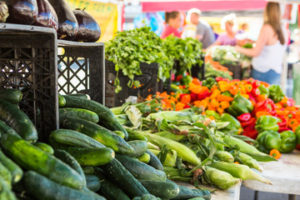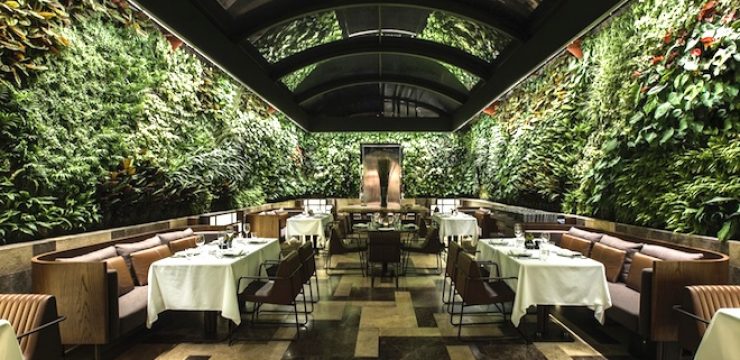Food and the environment are intrinsically linked. As a restaurant business owner, this puts you on the front line.
As environmental stewardship has jumped to the forefront of politics and societal trends, there has been an increase in vegan restaurants, gluten-free alternatives, organic eateries, zero-waste coffee shops, and local-grown markets. As the food industry aligns with more ecologically sound practices, it’s a good idea as a restaurant business owner to be on the right side of history.
Here are five easy steps you can take in your restaurant business to promote and encourage sustainable and eco-friendly behavior.
Use Organic Ingredients
Organic ingredients are chemical-free. This means they don’t contain synthetic herbicides, pesticides, and fertilizers.
While there is a scientific argument on both sides, evidence strongly points toward the environmental damage caused by these chemicals. When these substances run off fields during rainstorms, they wash into waterways, polluting the water and killing the aquaculture beneath. Equally, pesticide-use wipes out whole species of necessary bugs. This is why France now has a blanket-ban on bee-killing pesticides.
The use of these chemicals in agricultural farming is also harmful to humans. Recent court verdicts have linked pesticide use to cancer, awarding victims billions from big pesticide producers.
While USDA Organic certification has its limitations, it does help you identify products that are around 95% organic. Look for ingredients that are USDA Organic certified or equivalent.
Understand though, that when working on a local level, many small farmers can’t afford organic certification but produce their crops and meats without any chemicals. You can often find this out by chatting with them or checking out their website and social media.

Reduce Your Food Waste
When you own a restaurant business, food waste can be a big hit to your profits. There are a few ways to combat food waste, from recycling the food to downsizing the portions.
Balancing portion size with customer satisfaction is key to creating value for money for the customer and less food wastage for you. In other words, you want your customer to eat all their food and feel the portion was enough for the money they paid, but not too full that they leave lots over. If their plates are bursting with leftovers, you incur the cost when you throw it away.
One idea would be to offer a reduced portion size. Imagine you’re not very hungry, or you’re a bit low on funds, but you’re meeting your family for dinner. If there is a large plate that costs a fair amount, you may opt to splash out, but you may also opt for nothing at all.
Now imagine there were half portions available. You could now eat a more reasonable amount on a more affordable budget. For the restaurant, they still get profit, while you’re less likely to waste food. Alternatively, you can provide a takeaway option for leftovers, with biodegradable boxes.
For those kitchen scraps that do need to be thrown out, you can start a compost pile. If you have a garden or land outside your restaurant, you can use this compost to grow produce for the kitchen. A small flock of hens will also provide you with eggs, while they eat the kitchen scraps. They’ll also fertilize your restaurant garden naturally with their manure!
If you have produce that’s going bad, you can always choose a spontaneous ‘Dish of the Day.’ People love to reduce their choices and so will often pick the ‘Dish of the Day’ to make it easier. This gives you a great opportunity to get creative in the kitchen while lessening food waste and increasing profits that would have been thrown out with the overripe bananas.
Source Local, Sustainable Produce
Sourcing locally helps to keep money in the local economies. When we order food from huge corporate distributors, we kick a long supply chain into action all over the world. This sucks profits, taxable income, and jobs out of the local (and national) economy. However, when we pay farmers directly for their cattle, we keep profits in the community to help that community thrive.
Equally, when we source our food locally, we reduce its carbon footprint. Fewer miles from seed to sale mean lower amounts of fossil fuels burned from travelling in trucks and cargo containers.

Grow Your Own
To really reduce food miles, you could grow your own fruits and veggies. While it would be difficult to produce enough for a restaurant without taking on an army of staff, you can easily supplement herbs and spices. You could also grow fruit and nut trees for large harvests. This would work especially well if your menu were seasonally adaptable.
You may also find that growing your own small batches enables you to produce specialized ingredients to enhance your dishes. Try making apple cider vinegar from your apple trees in your beer garden or fresh strawberry jelly from strawberries on your rooftop restaurant. Perhaps you make onions chutneys from windowbox onions in the kitchen or elderflower syrup from pots on your bistro terrace.
Whatever your set up, you can get a little more green by growing your own. Not only will you shrink food miles, cut out packaging, and provide high-quality organic produce, but you will also be adding plants for bees, butterflies, birds, and bats to pollinate when the feed!
 Reduce Packaging
Reduce Packaging
It’s great to give customers a ‘to-go’ option, especially when considering food waste. However, plastic takeaway boxes and waxed cardboard containers are extremely pollutive. Think about switching these out for biodegradable alternatives.
You could also reward people for bringing their own containers by granting them a discount on their purchase.
If you’d like to boost your profits a little and encourage your customers to go green, why not sell zero-waste alternatives that people can use over and over.
Cutting out single-use plastics should also be a priority, denying customers straw, plastic cutlery, and plastic bags. Instead, opt for providing biodegradable alternatives for free or zero-waste alternatives as a profit booster.
Eco-Friendly Cleaning Products
Industrial cleaning products aren’t just toxic to the skin; they pollute waterways and topsoil just like other chemicals. There are a whole host of eco-friendly brands that uphold food hygiene standards without containing toxic chemicals. You can also make your own using orange peels and white vinegar.
You could even extend this idea out to cosmetic products like washroom and kitchen soap. This could be an opportunity to collaborate with another local business who makes natural soaps, encouraging community networks, and supporting local trade.

In Short
With agriculture and food practices being held over a barrel, it’s clear that the right route for restaurant business owners is to head down the eco-friendly road.
Not only will you find an abundance of target customers, from eco-conscious vegans to health-obsessed yogis, but you will also have an opportunity to collaborate with local businesses, get creative with seasonal produce, and boost your profits with add-on products (like zero-waste cups and strawberry syrup).
Cutting back on packaging, composting food waste, and using organic, locally-sourced ingredients is not too difficult a challenge. It does provide you with a more sustainable path to success, however, while setting an example to your customers and fellow restaurant owners.

